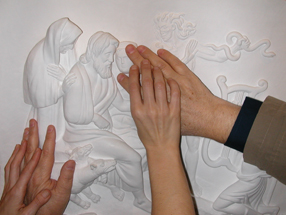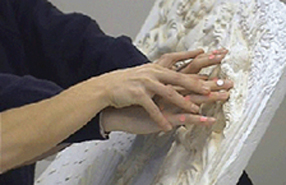|
From the Point of
View to the Point of Being by Loretta
Secchi Research on tactility at the University
of Toronto. |
|
The
Point of Being
is
the title of a new publication by Derrick de Kerckhove, researcher in
knowledge media of international repute. In July 2007, he brought together
at the University of Toronto, in Canada, a few experts on aesthetic and
perception of tactile and visual values, to develop an editorial project
of which he provided the original idea and is the
co-author. The venue
for the meeting was The McLuhan Program in Culture and Technology, a
wonderful site for its history and cultural value, and touching as well
since Kerckhove, now the Centre's Director, was once one of its brilliant
students and the assistant of a long-time researcher, Marshall McLuhan,
who gave his name to the Centre. In the red-brick building's rooms,
located in the heart of
the University, in Queen's Park, the lively atmosphere immediately
transpires a tradition of hospitality towards students and researchers: the
Institution's sensitivity and intellectual honesty have been preserved
since its foundation to this day. Because of this prestigious invitation,
it was possible to participate in the collaborative draft work dedicated
to the potential of tactile perception as another modality for seeing and
feeling. During our stay, discussions between colleagues and shared
activities of study and integration between different, not divided,
material gave a new perspective on the meaning that contemporary society
attributes today to communication and knowledge sharing. In intense
working days, we dealt with the subject of structured classification
introduced, from Modern age, by the perspective vision of space to
gradually arrive to the reasons for a virtual perception, distinctive to
contemporaneity. Moreover,
we considered the anthropology of touch in its scientific and
psychological contribution.
We
owe in fact to the great masters of the Anglo-Saxon school of the last
century and their studies, which cannot be disregarded, the first
theoretical reading of the idea of syntactic prospective vision and
paratactic continuous vision, of diachrony and synchronicity,
introductions to hyper-textual culture, basis for the modern theories on
communication applied to the network. The role of the various cognitive and
expressive functionalities, that we activate when we perceive the world
and give it a meaning in relationship to what we are, makes us think about
what we could become by means of an education to intensive sensory
integration towards sensitivity and identity even in accordance with
communication and information ethics. |
Derrick
de Kerckhove has planned that the publication be first and foremost a
reflection on the development of society deriving from the adaptation to
vision and which requires a change of attitude to contrast with
the risk of loss of sharpness in the sensory experience.
Only
the intellectual re-elaboration of our interpretation, generated by the
concrete and harmonious agreement between perception and understanding,
can help us understand changes in the state of conscience between surface
and depth. No
spiritualistic breach characterizes the study of the system by this man:
his clear vision of the history of spirit between the potential and the
limits of conscience, in the intentional and unintentional activation of
communication, in the effective relation between knowledge, in a
globalized vision of the individual. A careful
evaluation of the authentic meaning of interconnectivity that the scholar
has been forever studying is at the basis of a comparison between tactile
physiology and cognitive function of contact. The simulated reproduction
of perceptual effects from the haptic experience, form of communication
and extension of the potential of touch, is studied at the Adaptive
Technology Resource Centre (ATRC) of the University of Toronto, and is
focused on leading-edge research based on the application of high
technology for visual disability. In this environment, studies have led to
the development of interfaces that can provide pressure sensations,
density of substances, and surface temperature. These advanced
representations are not inappropriate substitutes to the real tactile
experience, but experiences without aesthetics and creations of codified
effects able to provide some haptic and functional sensations that make it
possible to read plans and environments. There is in fact a substantial
difference between the informative function generated by the tactile
sensation induced by stimulation, and the contact with tactile images.
This requires an education to touch and a cognitive act which lead to the
meaning of shape, therefore to the aesthetic emotion, in which the mental
reconstruction of a representation is based on its iconographic and
iconological meanings, poetical and aesthetic. The education to perception
through the process of training necessary to the development of perceptual
tactile abilities surpasses but does not elude pure cognition.
|
Tactile reading
of a work of art
Tactile reading with sensors
|

